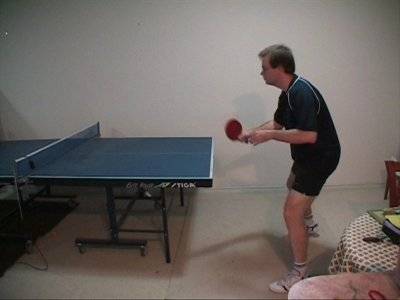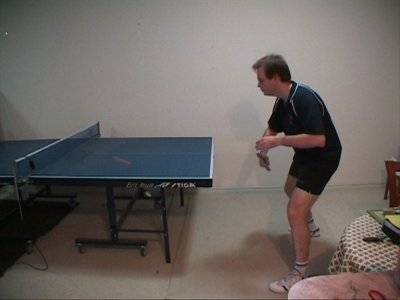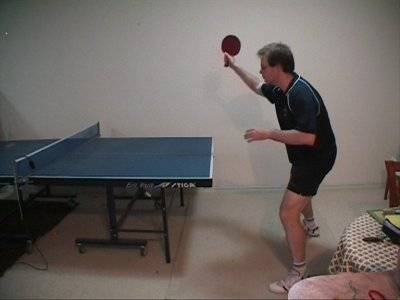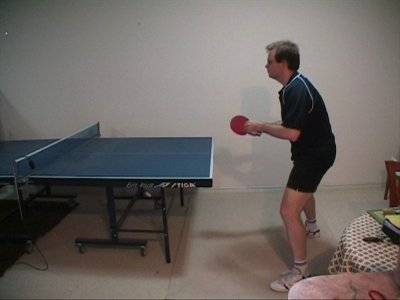We have already looked at the forehand counterhit, so now we will look at what should probably be the second table tennis stroke that you learn – the backhand counterhit. This stroke is the foundation of all backhand topspin strokes, so by learning how to hit it correctly, you will find it easier to learn the more advanced strokes such as the backhand drive and loop, which are essential for high level play.
In the backhand counterhit against light to medium topspin, the idea is to hit the ball over the net with medium speed and a little topspin to help bring the ball down on the other side of the table.
Ready Position

© Greg Letts
Points to look for:
- The feet are placed with the right foot slightly further back than the left foot. This is because there is no weight transference forward, and the slight loss in power caused by having the left foot forward is more than compensated for by already being in the correct stance for a forehand counterhit.
- The weight is evenly distributed on the balls of the feet to allow quicker movement. Too much weight on the heels will slow down movement, and too much weight on the toes will affect balance.
- The knees are bent and the feet are around one and a half times shoulder width apart. The torso is also leaning slightly forward to give better balance and movement.
- Shoulders are in line with the legs.
- The arms are held roughly shoulder width apart, with around a 90 degree angle at the elbow. The bat should be above the table to allow easy stroking of short balls.
Beginning Of Backswing

© Greg Letts
The ball is coming to the backhand side and the decision has been made to play a backhand counterhit. The backswing begins the stroke.
Points to look for:
- The right foot has lifted at the heel a little, as a small amount of bodyweight shifts to the left.
- The hips, waist and shoulders have also turned to the left, although the head is still facing forward watching the ball.
- The bat has only moved slightly backwards at this point. The amount that the bat moves backwards will vary from player to player, and will also be affected by the amount of power the stroke is hit with.
- The left arm has not moved significantly, and will not do so throughout the stroke. Since very little weight is shifting, it is not required to move it for balance, and it is better left in the same position.
End Of Backswing

© Greg Letts
The ball is about to bounce on the table, and the backswing has finished.
Points to look for:
- The bodyweight has moved a little onto the left leg, but is still fairly even.
- The left arm has not moved, and the right arm has bent at the elbow to the left, so that the forearm is parallel to the endline of the table.
- Notice that the shoulders have turned more than the hips and waist.
- Both shoulders have lowered a little, as the player continues to get into position. The right hand is at a height that is a little lower than the expected maximum height of the bounce of the ball. Note that the right hand is not directly underneath the left hand, but is around six inches or so to the right of it horizontally.
- The head has lowered to allow the player to keep watching the ball comfortably and closely.
- The player is directly behind the ball, with the ball roughly in the centre of his body.
- The angle of the bat is about 45 degrees, with the top edge of the bat pointing towards the camera.
Contact With The Ball

© Greg Letts
Contact has been made with the ball.
Points to look for:
- The player has watched the bat contact the ball.
- The hips, waist and shoulders have not turned appreciably from their position at the end of the backswing. They would be turned if extra power was required.
- The forearm and bat are moving faster than the shoulders, as shown by the slight blurring in the photograph.
- If the ball was compared to a clockface, the bat has made contact at a point roughly around the number 2, while the bat was moving mainly forwards and slightly up. Note that the angle of the bat remains at around 45 degrees. This movement makes the ball go mainly forward and a little upwards, with a light amount of topspin generated by the small brush of the ball.
- Contact has been made between the left hand side of the torso and the middle of the body.
End Of Forward Swing

© Greg Letts
The forward swing has come to an end, and the ball is on its way.
Points to look for:
- The player is now watching his opponent at the other end of the table, rather than the flight of the ball.
- The hips, waist and shoulders have not turned, since the extra power they would provide was not needed.
- The hips, waist and shoulders are a little higher than the original ready position, since the legs have pushed up a little to help lift the ball.
- The follow through is probably higher than is really necessary. A finish at around shoulder level would be more appropriate for a counterhit.
Return To Ready Position

© Greg Letts
The player returns to his ready position before the next stroke.
Points to look for:
- The right foot has dropped as the weight of the body has come back to an even distribution.
- The player simply had to let his right arm drop a little to have his bat back into the ready position. Note that the bat is pointing forward in a neutral position, and is not left in place for another backhand.
- The waist, hips and shoulders have returned to their original position.
- His knees have begun to bend as he returns to his basic crouch position.
- His bodyweight is again evenly distributed between his left and right legs, and on the balls of his feet.

